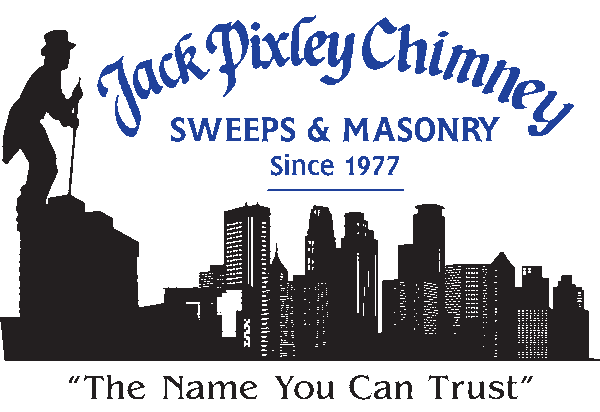Temperatures are dropping, leaves are changing and starting to fall, and many parts of the country have experienced the first snowfalls of the season. Fall is in full swing, and winter is just around the corner! With the change in the weather comes a change in how we use our heating appliances; fall and winter are known as burning seasons because of how often fireplaces, inserts, stoves, and other fuel-burning heating appliances are used.
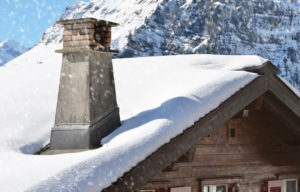 The Farmer’s Almanac has predicted that this winter will have big chills and strong storms; a fireplace can help create a warm, welcoming environment in your home no matter the weather. While chimney systems are built to burn fires year after year, they do need regular care, maintenance, and upkeep in order to operate safely and efficiently. The following tips and tricks can help ensure your fireplace and chimney are ready for the arrival of burning season.
The Farmer’s Almanac has predicted that this winter will have big chills and strong storms; a fireplace can help create a warm, welcoming environment in your home no matter the weather. While chimney systems are built to burn fires year after year, they do need regular care, maintenance, and upkeep in order to operate safely and efficiently. The following tips and tricks can help ensure your fireplace and chimney are ready for the arrival of burning season.
1. Schedule a sweeping and inspection as soon as possible
Burning season may be underway, but it’s still not too late to schedule a chimney sweeping and inspection! A chimney sweeping should be done at least once per year to remove soot, ash, and flammable creosote from the flue; likewise, inspections should be done annually to check for signs of damage or deterioration to the fireplace or chimney.
A chimney sweeping by a CSIA-certified chimney sweep can help ensure your fireplace is burning efficiently, extend the life of your chimney system, and significantly reduce the risk of a chimney fire. Fall and winter are the busiest seasons for chimney sweeps; because of this, it may take several weeks before your appointment can be scheduled. Want to beat the rush next year? Plan ahead and schedule your chimney maintenance in the offseason!
Have a gas fireplace? You still need to schedule a chimney inspection! Annual inspections of gas fireplaces are important to ensure that no components have shifted, no gas leaks are occurring, and the venting system is undamaged and has no blockages.
2. Choose the right firewood
Whether you have an insert, open-hearth fireplace, stove, or even an outdoor fire pit, the best fuel for your wood-burning fire is seasoned firewood. According to the CSIA, seasoned firewood is “wood that has a moisture content between 20-25%.” This low moisture content is achieved by cutting, stacking, and exposing wood to the elements for 6-12 months.
Seasoned wood produces less smoke, burns at a higher temperature, and produces less creosote than freshly cut or “green” firewood. Burning green wood should be avoided whenever possible; in addition to being difficult to ignite because of the high moisture content in the wood, green wood burns dirtier and produces excessive smoke – and creosote. Burning large amounts of greenwood often result in a mid-season call to the chimney sweep!
While it can be tempting to burn paper, packaging materials, or leftover scrap wood in the fireplace – particularly when unwrapping presents during the holidays – only firewood should be used in indoor fireplaces. Styrofoam, stained or painted wood, or even printed paper can release dangerous chemicals when burned; this can impact the air quality in your home or cause respiratory issues for friends and family. Likewise, burning plastics can melt onto fireplace components and cause long term damage to the chimney system.
3. Maintain smoke detectors and safety equipment
In the United States, three out of five fire-related deaths were in homes without working smoke alarms. Regularly testing and replacing smoke alarms, carbon monoxide detectors, and fire extinguishers are an important part of keeping friends and family safe when the fireplace is in use. Smoke and carbon monoxide detectors should be on every level of a home, as well as outside sleeping areas. Test alarms every six months and replace batteries as needed; replace safety equipment every 7-10 years to ensure they meet modern safety standards and technology.
A fire extinguisher should be purchased and placed in an easily-accessible area near the fireplace. Available at almost every big box or home improvement store, a working fire extinguisher can be used to prevent an unsafe situation from turning dangerous. A log rolling out of the fireplace, a fire burning out of control, or a stray ember landing on nearby furnishings are all situations where a fire extinguisher can help prevent devastating damage to a home.
4. Keep décor away from the fireplace
The stockings may have been hung by the chimney with care – but they need to be moved before the fireplace is used! During the holidays – and year-round – our mantles can hold décor such as garland, bunting, mementos, and more. Moving any hanging mantle décor out of the way before the fireplace is used can prevent stray sparks or embers from accidentally igniting a stocking; likewise, all carpets and other furnishings should be at least three feet away from the fireplace when in use.
Contact Jack Pixley Sweeps for your chimney needs this burning season
Following a few simple tips can keep your home safe and stress-free this burning season. Since 1977 staff has been providing the Minneapolis/Saint Paul area with quality, trustworthy fireplace and chimney services. For more information on fireplace safety or to schedule your next chimney sweeping or inspection, contact Jack Pixley Sweeps today!
At Jack Pixley Sweeps, safety is our top priority. Through high-quality fireplace and chimney services and client education, 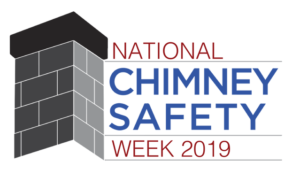 we aim to keep our friends and neighbors’ homes safe, warm, and efficient. We are proud participants in Chimney Safety Week 2019.
we aim to keep our friends and neighbors’ homes safe, warm, and efficient. We are proud participants in Chimney Safety Week 2019.
In the United States, there are more than 22,000 chimney fires each year, endangering lives and costing more than 125 million dollars in damages. The goal of Chimney Safety Week is to help reduce the number of accidental chimney fires by educating both homeowners and chimney professionals about the latest trends and best practices in fire safety and prevention.
Facts about chimney fires
Chimney fires are a risk when using any fireplace, stove, or insert. However, chimney fires can be prevented by chimney sweepings, inspections, regular maintenance, and following safe burning guidelines. The following are some eye-opening facts about chimney fires many homeowners may not know.
- The majority of chimney fires go undetected. Many chimney fires are so small they go undetected. This does not mean, however, that the chimney is not damaged; no matter how small, chimney fires can cause serious damage to the flue.
- Chimney fires can reach up to 2,000 degrees
- Creosote buildup is the main cause of chimney fires. Creosote is a naturally occurring – and extremely flammable – byproduct of combustion. When not removed from the chimney during chimney sweepings, creosote can accumulate in the flue; stray sparks or embers from the fireplace can then cause creosote to ignite and lead to a chimney fire.
- Signs of a chimney fire include a discolored chimney cap, warped metal on the damper, creosote flakes in the flue box, cracks in the masonry, and more.
Fireplace safety tips
Our fireplaces and chimneys help keep our homes warm, but they can be dangerous when poorly maintained or when used incorrectly. The following are just a few safety tips to help prevent accidental chimney fires,
- Have the chimney swept at least once per year. Chimney sweeping is the single most important part of chimney maintenance and fire prevention. A chimney sweeping by a certified professional removes soot, ash, and creosote from the fireplace and flue; this ensures that the chimney can vent safely and efficiently no matter the season.
- Do not leave fires unattended. No matter the size or experience level of the homeowner, fires should never be left unattended. This safety tip is especially important in homes with pets or small children who could easily be injured by fire. Glass doors, grates, or fences can be used to help keep little hands – and paws – away from the fireplace when it is in use.
- Keep décor away from the fireplace. Hanging stockings on the mantle may be one of the most popular ways to decorate for the holidays, but home décor should always be removed before using the fireplace. Keep carpets, furnishings, and other décor at least three feet away from the fire to prevent scorch marks – and accidental fires.
- Properly store fireplace ashes. Fireplace safety doesn’t end when the fire goes out. Proper ash storage is an important part of preventing fires in trashcans or dumpsters; ashes should always be stored in a dedicated metal container and should not be mixed in with household trash.
Using these tips and having your chimney swept annually will help you decrease your risk of a chimney fire and keep your family and home as safe as possible. For questions, call Owens Chimney today!
A musty smell coming from the fireplace. Smoky odors that come and go in warm weather. Rotting smells from the chimney that start suddenly.
What is causing my stinky chimney?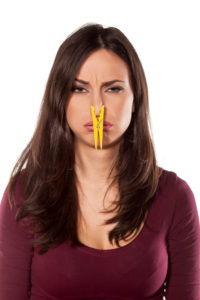
Chimney odors can start suddenly or build gradually. They can come and go or be constant. No matter what they smell like or how strong they are, chimney odors are the result of a more serious chimney problem. Because of this, it is important to uncover the root cause of the chimney smell, make any necessary repairs, and keep chimney odors from coming back.
What is causing my chimney odor?
There is no one singular cause for chimney odors. Because of this, a chimney inspection by a certified chimney sweep is often needed to uncover the root cause of a stinky chimney. The type of odor it is, how strong it is, how long it has lasted, and other factors can all help a chimney sweep uncover the source of a smell.
There are three primary causes of chimney odors.
1.Animal entry
Type of odor: Sharp, sudden, rotting smell
Cause of odor: Animals in the chimney are more than a nuisance; they can cause serious damage – and serious odors! Sudden, sharp smells accompanying by crying, scurrying, or scratching from the chimney are the most common signs of animal entry. Animal droppings, dried nesting materials, or even dead animals can cause odors that overwhelm the air quality in the home. In addition, animals can introduce microorganisms, pests, and bacteria into your home; because of this, they should be professionally removed as soon as possible.
2. Creosote
Type of odor: Smoky or dirty, especially during humid weather
Cause of odor: Creosote is a naturally occurring byproduct of combustion; it is a dark, sticky substance that accumulates in the flue. When the chimney is not regularly swept or the wrong fuel source has been used, excessive creosote can build up in the flue and cause odors. Smells associated with creosote in the flue are often most noticeable during hot or humid weather.
3. Water entry
Type of odor: Damp or dank
Cause of odor: The exterior of the chimney is designed to not be affected by moisture, but interior fireplace components are not. While they are designed to withstand extremely high heat, even small amounts of moisture from a chimney leak can cause significant problems. Because chimneys are often cool and dark, water has trouble evaporating; these conditions, along with water, can cause mold or mildew growth. This can lead to damp or dank smells – and seriously impact the air quality in the house.
Get rid of your chimney odor with an inspection!
If a chimney odor is affecting the air quality in your home, don’t reach for the air freshener – call a chimney sweep! Contact the experts at Jack Pixley Sweeps today to schedule your next chimney inspection. Our chimney sweeps can help uncover the root cause of your chimney odor, repair any damage, and permanently get rid of your chimney odor.
Spring has officially arrived, and warmer weather is right around the corner. This means we have new, spring discounts for you to take advantage of! With four incredible coupons available for our customers, now is the perfect time for fireplace and chimney services.
$40 off a chimney sweep that includes an inspections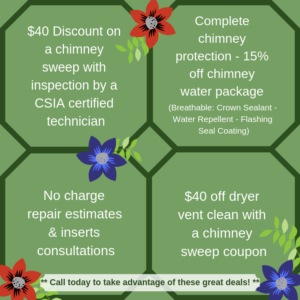
Our first spring coupon gives customers $40 off a chimney sweeping that includes an inspection. This special helps ensure your fireplace is clean and safe after a long winter of use – while helping you save money!
Regular chimney maintenance, including sweepings and inspections, is the best way to keep your fireplace burning safely and efficiently. Chimney sweepings help remove soot, ash, flammable creosote, and other blockages from the flue. Chimney inspections help ensure that the entire fireplace and chimney system is in good condition and free from areas of damage or deterioration.
Annual maintenance is recommended by major safety organizations as well. The Chimney Safety Institute of America recommends all homeowners have their chimneys swept at least once per year – if not more; the National Fire Protection Association recommends all fireplace be inspected at least once per year as well.
Complete chimney protection – 15% off chimney waterproofing package
Now that spring is here, we know that rain is right around the corner. To ensure your chimney is ready, we are offering our second spring discount, 15% off our chimney waterproofing package. Water is the leading cause of masonry damage. Guarantee a prepared chimney by having out team waterproof your system!
No charge repair estimates
Whether you have a chimney leak, damaged masonry, or want to reface your firebox, now is the perfect time to call one of the chimney experts at Jack Pixley Sweeps [https://jackpixleysweeps.com/]. Our third spring discount gives customers the opportunity to receive no charge repair estimates; if you have a chimney or fireplace repair that needs to be completed, stop putting it off and call for your no charge repair estimate today!
$40 off a dryer vent cleaning with a sweep
We might be known for our fireplace and chimney services – but we can clean your dryer vents, too! Our fourth spring coupon gives customers $40 off a dryer vent cleaning with a chimney sweeping.
The same lint that accumulates in the lint trap after each load can build up over time in the dryer vents. This is harmful in two ways. First, lint build up can restrict air flow in the dryer vents, forcing the dryer to work harder and negatively impacting performance. Second, lint is extremely flammable. The superheated air the dryer produces as it compensates for restricted airflow can ignite and lead to an accidental dryer fire. Cleaning dryer vents can improve dryer efficiency while reducing the risk of dryer fires.
Don’t forget about your masonry repairs, too!
Early spring is the perfect time of year to take care of any masonry repairs that may have arisen over the winter. The weather is perfect for masonry to cure properly. The weather ensures your repairs are completed as quickly as possible. Likewise, spring is often a low-use season for fireplaces. Having repairs done now ensures your fireplace will be ready to use again next fall.
Make sure you are gearing up for spring properly, by taking advantage of our seasonal deals! Contact Jack Pixley Sweeps today for more information about how to take advantage of our spring coupons!
With fall in full swing, days getting shorter, and temperatures dropping, many homeowners are scrambling to have their chimney’s swept before winter arrives. However, it can be difficult to tell the good from the bad when it comes to chimney sweeps. Instead of price shopping or hiring the first person that comes to your door, make sure to trust your chimney system to a certified professional this year.
Are all chimney sweeps certified?
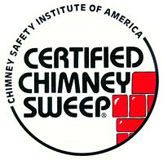
The mark of a CSIA certified chimney technician
The fireplace industry was unregulated for many years; this allowed anyone with a few brushes to call themselves a chimney sweep. Unfortunately, many of these “professionals” were untrained, seasonal workers who did nothing more than move soot and ash around and leave behind dirty fireboxes and floors.
For more than 30 years, the Chimney Safety Institute of America, or CSIA, has worked to regulate the fireplace industry by certifying chimney sweeps. Their education and training to industry professionals helps to prevent chimney fires and increase public awareness of safety issues surrounding fireplaces and chimneys.
Why hire a CSIA certified chimney sweep
The CSIA certification is the gold standard of education and training in the fireplace industry. CSIA certified sweeps have undergone years of rigorous education and testing on subjects including:
– Safety practices
– Fireplace and chimney building dynamics
– Local and national fire and building codes
– Maintenance and installation of gas heating appliances
– Current EPA emissions standards
In order to maintain their CSIA certifications, sweeps must complete continuing education courses and retest every three years. This ensures that CSIA certified sweeps are always up to date on the latest advancements in the fireplace industry.
Finding the right chimney sweep
While homeowners should do their research before hiring a chimney sweep, price shopping will find you savings – but rarely the best chimney services. Instead, look for a company with CSIA certified chimney sweeps, several years of experience, and a good professional reputation. The following are some examples of questions to ask before hiring a chimney sweep.
– How long have you been in business in this area?
– Do you have references available from current customers?
– Does the company or individual chimney sweep carry liability insurance?
– What is your rating with the Better Business Bureau? Are there any complaints filed against you currently?
– Will the chimney sweep who works at my home be CSIA certified?
Working with a professional chimney sweep makes a difference!
Chimney sweeps have come a long way since the days of Bert and the singing sweeps from Mary Poppins! Modern chimney sweeps are educated, certified, and trained professionals who can do much more than simply clean your flue.
Jack Pixley Sweeps are proud that all of our sweeps are CSIA certified; this gives our customers confidence knowing they are working with knowledgeable, reliable professionals. For more information on the importance of working with a certified chimney sweep or to schedule your next appointment, contact Jack Pixley Sweeps today!
 The Farmer’s Almanac has predicted that this winter will have big chills and strong storms; a fireplace can help create a warm, welcoming environment in your home no matter the weather. While chimney systems are built to burn fires year after year, they do need regular care, maintenance, and upkeep in order to operate safely and efficiently. The following tips and tricks can help ensure your fireplace and chimney are ready for the arrival of burning season.
The Farmer’s Almanac has predicted that this winter will have big chills and strong storms; a fireplace can help create a warm, welcoming environment in your home no matter the weather. While chimney systems are built to burn fires year after year, they do need regular care, maintenance, and upkeep in order to operate safely and efficiently. The following tips and tricks can help ensure your fireplace and chimney are ready for the arrival of burning season.